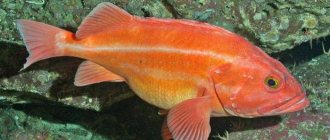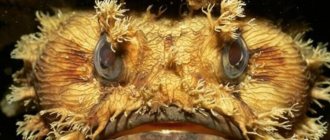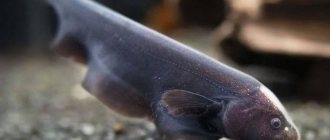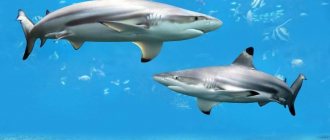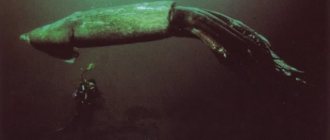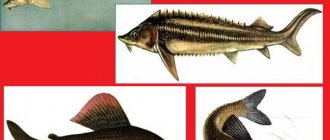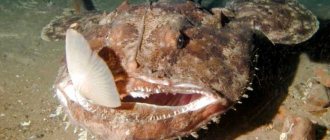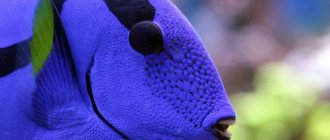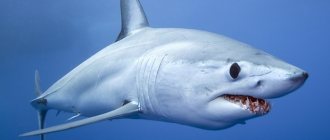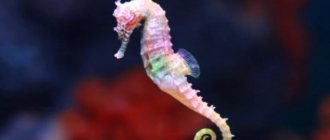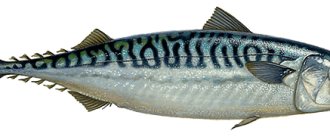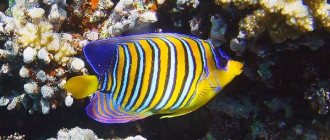When did fish appear?
Lobe-finned fish
It is believed that the first ancestors of modern fish began to appear about 400 million years ago. In the process of evolution, they were divided into two main groups: ray-finned and lobe-finned.
A characteristic feature of ray-finned fish was the appearance of paired fins and a swim bladder, due to which they acquired a streamlined shape and the ability to swim well, and they had gills. From this group are mainly derived the species of fish known today.
Lobe-finned fish lived in fresh water bodies and had powerful fins with rounded blades.
The end of the Devonian period was marked by climate change. Many reservoirs dried up, which forced the lobe-finned species to adapt to the new environment. During evolution, they first develop jaws, then the swim bladder transforms into lungs, and the ability to move with the help of fins appears. Millions of years during which they adapted to changing living conditions made these creatures unique and very beautiful.
Wart
This monster is one of the ugliest and most poisonous inhabitants of the ocean. Belongs to the Scorpionaceae family. It lives on the coral reefs of the Indian and Pacific oceans, the coast of Australia, the Red Sea, off the African continent, and the southern waters of Asia.
Large representatives of the species reach 60 centimeters in length. Warts have no scales at all; their body is covered with numerous growths and bumps, making them look like rocks covered with algae. Hence another name: “stone fish”.
Thanks to its inconspicuous brownish coloration, the stonefish is invisible to predators. During the day it lies buried in the sand. Seeing a fish swimming past, the wart suddenly jumps out in its direction and swallows the victim with its huge mouth turned upward.
The fish's deadly weapon is the poisonous spines of the dorsal fin, which contain toxins that cause severe pain, paralysis, and tissue necrosis.
Where did fish come from?
Drawing of Agnathia, one of the supposed ancestors of fish.
There are many different hypotheses according to which fish could have evolved from echinoderms, from arthropods, and even from annelids.
Some scientists consider the ancestors of fish to be small marine animals belonging to the subphylum Acrania. They lacked much of what is characteristic of modern fish: jaws, teeth, fins, sensory organs, etc. About 440 million years ago, jawless armored fish-like creatures appeared - Agnatha, which, although they did not yet have jaws, had already started in front the exoskeleton and, in some cases, fins are formed. In parallel with them, Placodermi - jawed armored fish - began to appear. These species, as well as the maxillobranchs - Acanthodii, could not survive to modern times.
Pufferfish
In appearance they resemble a porcupine. The reason is sharp spines that straighten out when danger is detected or the threat of an attack is detected. They are called rocktooth, dog fish. Pufferfish are inhabitants of salt and freshwater bodies of tropical and subtropical zones.
The body of the pufferfish is shortened, 30 centimeters long. Some areas are covered with three-supported spines that fit tightly to the body. The head is large, the back is rounded and wide.
Near the fish's stomach there is a bag filled with air. Once on land, the pufferfish swallows oxygen, inflating like a balloon. Once in the water, it floats belly up on the surface. Then he noisily releases the air from the bag and lowers himself, trying to hide. Under water, in the absence of secluded places, the bag inflates, turning into a prickly ball, with sharp needles protruding from all sides.
Interesting! The liver, skin, gonads, and abdominal cavity of pufferfish contain the toxic substance tetrodotoxin, which causes severe convulsions, pain and often leads to death.
But, nevertheless, pufferfish meat, after cleaning the poisonous parts, is considered an exquisite delicacy and is eaten. The “exotic” dish is especially popular in Asian countries. In the Japanese version: "fugu" . The fish is prepared by experienced, trained professionals. In the absence of skills in handling fugu, eating meat ends in death.
Freshwater species of Amazon, Nile and Congo Pufferfish are highly valued by aquarists.
Structure of fish
Fish have a unique body structure that allows them to live underwater. This helps them successfully live in a given environment, search for food and interact with each other.
Internal structure
Internal structure of fish
Fish assimilates food through the digestive system. Food is swallowed by mouth and passes through the pharynx into the esophagus. From there it enters the stomach, where it is digested. Waste is directed to the intestine.
The respiratory system allows you to obtain oxygen under water. In the fish's throat there are slits made up of septa and gills. The latter consist of arcs, plates and capillaries. They absorb oxygen from the liquid and release carbon dioxide.
The circulatory system of fish is closed, with one circulation. It works due to a two-chambered heart.
The nervous system consists of the spinal cord and brain. The latter is divided into five departments, and each performs a specific function. The nervous system regulates blood circulation, ensures the functioning of the organs of vision, breathing, digestion, etc. The excretory system consists of primary and ribbon-shaped kidneys. Thanks to their work, waste is released from the fluid in the body, which is subsequently sent into the environment through special holes.
External structure
External structure of the fish
Due to the flattened sides of the body, fish have good streamlining, which allows them to successfully maneuver under water. Most species have a distinct head, body and tail. The limbs are fins that help move.
The surface of the body is covered with scales. In most cases it has the shape of a hexagon. You can also determine the age of a fish by its scales, since it has annual rings. On the surface of the body there are skin glands that secrete mucus. It covers the scales and improves gliding when swimming.
The head of the fish contains the mouth, nostrils and eyes. The latter do not have eyelids, their cornea is flat. Inside the skull is a hearing organ called the inner ear. The head also contains a balance organ, which allows the fish to understand its position in space.
Sabertooth
These evil predatory fish are inhabitants of the tropical, moderately warm seas of all the oceans of the planet. They have an unattractive, terrifying appearance.
The head of the fish is massive, large, with protruding comb-like processes. There are huge fangs on the upper and lower jaws. The front teeth curve into the mouth. The eyes are small, the skin color is coal black. The skin is rough. The average length of an adult is 18 cm. The sabertooth weighs approximately 120 g. It feeds on small fish, squid, and crustaceans.
Young representatives of the species do not resemble adult fish. Their color is light, not so rich. There are four spines on the head, which is why sabertooth fry are called horned. Young specimens have no fangs. Sabertooths live at depths from 500 to 5000 meters. Despite their formidable appearance, they are hunted by many predators. Their dark color makes them unnoticeable in dark, deep water that receives little sun.
Freshwater fish
The habitat of such fish is fresh natural and artificial reservoirs. The group of freshwater or river creatures includes many species that differ from each other in their characteristics: size, appearance, habitats, etc. It is worthwhile to dwell in more detail on the main species and give some official data on their sizes.
Omul
Omul
Dimensions and weight of fish: 64 cm; 3 kg. Genus whitefish, salmon family. It is considered an anadromous fish, feeds in the coastal sea zone, tolerates salt water well, feeds on crustaceans and fish fry. Mainly inhabits rivers and lakes of Siberia. It goes to spawn in rivers that flow into Lake Baikal. Lives up to 20 years.
Pike
Pike
Dimensions and weight of fish: up to 1.5 m; up to 35 kg. Genus Pike-like, family Pike. Refers to predatory fish. Pike is especially common in the Yenisei basin, as well as in rivers flowing into the Yenisei Bay. It has an arrow-shaped body with a large head and an elongated front part. Body color differs depending on habitat. Lives up to 15 years.
Interesting: Why don't fish freeze? Description and photo
Chekhon
Chekhon
Dimensions and weight of fish: up to 60 cm; up to 2 kg. Genus Pelecus (single species), family Cyprinidae. Omnivorous fish, feeds on both plant and animal foods. During the day it tries to stay close to the surface of the water, and at night - at depth. With the onset of cold weather, it lies deeper into the pool. Chekhon is common in the middle and lower Volga and Ladoga. Lives for 9 years, in reservoirs - up to 13 years.
river eel
River eel
Dimensions and weight of fish: up to 50 cm (for males) and up to 1 m (for females); 3.5-7 kg, up to 12.7 kg, respectively. Genus Anguilla Schrank (river eels), family Eels. A predatory fish that resembles a snake in appearance. It has a long and laterally flattened body, a small head and small teeth. The shade varies, but most often it is green-brown, the back is the darkest. For living it prefers quiet water and the presence of shelter: holes, snags, thickets, etc. Lives on average from 9 to 15 years.
Interesting fact : when eels go to spawn, they stop eating and their intestines atrophy.
Silver carp
Silver carp
Dimensions and weight of fish: up to 1 m; up to 50 kg. Genus Hypophthalmichthys, family Cyprinidae. A large fish that leads a schooling lifestyle. Silver carp is common on the Amur. It feeds mainly on plankton and algae, making it an excellent ameliorator of water bodies. Prefers warm water and lack of strong currents. Lives up to 20 years.
river piranha
River piranha
Dimensions and weight of fish: up to 50 cm; 4 kg. Genus Pygocentrus, piranha family. The body is compressed at the sides, powerful jaws with sharp teeth. One of the most voracious predatory fish, mainly lives in schools in the rivers of South America. Belongs to the order Cyprinidae. The color is silver-blue, which darkens greatly with age; the shade is different in females and males. Lives up to 10 years.
Sterlet
Sterlet
Dimensions and weight of fish: 125 cm; 16 kg. Genus Acipenser (sturgeon), family Sturgeon. It has a triangular body with a sickle-shaped caudal fin elongated upward. It feeds on small mollusks, crustaceans, larvae, etc. Distributed in the river basins of Siberia and the European part of Russia. Listed in the Red Book. Prefers fast currents. Lives up to 30 years.
River ram
River ram
Dimensions and weight of fish: up to 35 cm; up to 2 kg. Genus roach, carp family. It feeds on both plant and animal foods: algae, larvae, small crustaceans, etc. Does not like fast currents, prefers tributaries, backwaters, and underwater holes. It lives in rivers flowing into the basins of the Black and Azov Seas. Lives up to 20 years.
Pink salmon
Pink salmon
Dimensions and weight of fish: up to 76 cm; 5.5 kg. Genus Oncorhynchus Suckley (Pacific salmon), family Salmonidae. It prefers crustaceans, larvae, fry, and small fish as food. Lives off the coast of Alaska, Kamchatka, Anadyr, Kuril Islands, Sakhalin, etc. Spends only 1 season at sea, then goes to rivers to spawn. Lives 1.5-2 years.
Zander
Pike-perch
Dimensions and weight of fish: up to 1 m; up to 10-15 kg. Genus Stizostedion (pike perch), perch family. Large predatory fish. Inhabits rivers and lakes in the basins of the Baltic, Black, Caspian and Aral seas, from the Danube and Elbe to the Urals; in the European part of Russia - from Karelia to Transcaucasia. Lives up to 14 years.
Carp (common carp)
Carp (common carp)
Dimensions and weight of fish: up to 1 m; up to 20 kg. Genus Cyprinus (carp), family Cyprinidae. It feeds on plant and animal foods. It lives in the basins of the Azov, Black, Caspian and Aral seas, in Central Asia, Central and Western Siberia and Kamchatka. Included in the Red Book, because is in danger of extinction. Lives from 30 to 35 years.
Burbot
Burbot
Dimensions and weight of fish: up to 120 cm; up to 18 kg. Genus Lota (burbot), burbot family. It feeds on invertebrates and small fish, incl. carrion. Distributed in rivers of Siberia, Europe and North America. It is especially active in cold waters and comes out to spawn in winter. Prefers reservoirs with a rocky or sandy bottom, where the water is clear and clean. Lives from 15 to 25 years.
Vobla
Roach
Dimensions and weight of fish: up to 35 cm; up to 0.8 kg. Genus roach, carp family. It feeds on mollusks and other invertebrates. It lives in large rivers of the Caspian Sea basin, such as the Volga. On average, it reproduces 5-6 times in its entire life. During hibernation, it lies motionless at the bottom and does not eat anything. Lives for about 10 years.
Common catfish
Common
catfish Dimensions and weight of fish: up to 5 m; up to 400 kg (according to historical data). Soma genus, catfish family. It mainly feeds on carrion, but also eats crustaceans, aquatic insects and fry. The predator, which is mainly active at night, lies down during the day on the bottom, in snags, etc. Inhabits rivers and lakes of the European part of Russia and Europe. Lives up to 40 years.
Ide
Ide
Dimensions and weight of fish: up to 90 cm; up to 6-8 kg. Genus Leuciscus (dace), family Cyprinidae. Omnivorous fish, feeds mainly in the evening and at night on animal and plant foods. Distributed in European countries, in most of Siberia, in some rivers of the Black Sea basin and in the northern part of the Caspian Sea. Lives from 15 to 20 years.
Rotan
Rotan
Dimensions and weight of fish: 14-25 cm; up to 0.3 kg. Genus Goloveshki, family Goloveshki. A predatory fish that feeds on zooplankton and small invertebrates. It lives in the Amur basin, northwestern Sakhalin, northern Korea and northeastern China. Can withstand freezing of a reservoir to the bottom, partial drying out and contamination. Lives up to 7 years.
Bream
Bream
Dimensions and weight of fish: up to 82 cm; up to 6 kg. Genus Abramis (bream), family Cyprinidae. Mainly feeds on snails, shells, insect larvae, and sometimes algae. It lives in flocks and prefers deep, overgrown places. It lives in the basins of the Black, Baltic, Caspian seas, in lakes of Karelia and the European part of Russia. Lives up to 23 years.
Interesting: Dangerous predatory fish: moray eel and barracuda. Description, photo and video
Roach
Roach
Dimensions and weight of fish: 10-70 cm; up to 3 kg. Genus Rutilus (roach), family Cyprinidae. It feeds on crustaceans, insects and algae. Distributed throughout Europe, in the basins of the Aral and Caspian seas, in the reservoirs of Siberia. It lives in flocks in places where there is a weak current, hiding behind snags. Lives until age 21.
Salmon (Atlantic salmon)
Salmon (Atlantic salmon)
Dimensions and weight of fish: 1.5 m; up to 43 kg. Genus Salmo (salmon), salmon family. It feeds on plankton, crustaceans, larvae, and small fish. Wide habitat: North Atlantic, Scandinavian Peninsula, Finland, Kola Peninsula, Karelia, Baltic, etc. Proposed for inclusion in the Red Book. Lives up to 13 years.
Golden carp
Golden crucian carp
Dimensions and weight of fish: 36 cm; up to 1.5 kg. Genus Carassius (crucians), family Cyprinidae. Fish resistant to adverse conditions. It feeds on larvae, worms, algae, and small mollusks. In addition to the European part of Russia, it lives in the Far East, Asia, Siberia, as well as in European and Asian countries, in the USA. Lives from 10 to 15 years.
Goldfish
Silver crucian carp
Dimensions and weight of fish: 46 cm; up to 3 kg. Genus Carassius (crucians), family Cyprinidae. The body height is less than that of the goldfish, and the scales are lighter and larger. It feeds on larvae, worms, algae, and invertebrates. It lives in the Amur basin, in Siberia and Europe, as well as in North America, India, etc. Lives from 10 to 12 years.
Gudgeon
Gudgeon
Dimensions and weight of fish: up to 15-22 cm; about 0.2-0.3 kg. Genus Gobio (minnows), family Cyprinidae. It feeds on larvae, worms, small crustaceans, but does not hunt, but collects from the bottom. Often becomes food for larger predatory fish. Stays on the bottom in schools. Widespread in Europe. Lives up to 10 years.
Sturgeon
Sturgeon
Dimensions and weight of fish: up to 6 m; up to 800 kg. Genus Acipenser (sturgeon), family Sturgeon. Omnivorous fish feeding on invertebrates, algae and small fish. Lives in the basins of the Azov, Black and Caspian seas, in the Far East, etc. It has practically no natural enemies in nature, with the exception of humans. Lives from 40 to 60 years.
Interesting fact : beluga is a long-lived fish. Her age can reach up to a hundred years.
River perch
River perch
Dimensions and weight of fish: up to 50 cm; 2 kg. Genus Perca (freshwater perches), family Percidae. Predatory fish, feeds on zooplankton, fry, and small fish. Distributed throughout almost all of Europe, in the northern part of Asia, in the Kolyma and Aral Sea basins. Prefers lowland reservoirs, but is sometimes found in high-mountain lakes. Lives up to 23 years.
Rudd
Rudd
Dimensions and weight of fish: up to 51 cm; 2.1 kg. Genus Scardinius (rudd), family Cyprinidae. An omnivorous fish that feeds on plankton, algae, larvae, worms, etc. Leads a schooling lifestyle. It lives in the basins of the Azov, Black, Caspian, Aral, Baltic and North seas. Lives up to 19 years.
White amur
Grass carp
Dimensions and weight of fish: up to 1-1.5 m; up to 45 kg. Genus Ctenopharyngodon (grass carp), family Cyprinidae. Prefers plant foods, but sometimes small crustaceans are also found in the diet. It lives in East Asia, in the lower reaches of the Amur, Volga and Don, in the lowland rivers of China and Vietnam. Lives on average 15 years.
Ruff
Ruff
Dimensions and weight of fish: up to 20 cm; up to 0.1 kg. Genus Percidae (ruffes), perch family. This unpretentious schooling fish feeds on crustaceans, larvae, worms, etc. It lives in water bodies of Europe, in the Trans-Urals and Northern Asia. It is found in both fresh and slightly brackish water bodies. Lives up to 11 years.
Rainbow trout (mykiss)
Rainbow trout (mykiss)
Dimensions and weight of fish: up to 40-50 cm; up to 0.8-1.6 kg. Genus Oncorhynchus Suckley (Pacific salmon), family Salmonidae. A predatory fish that feeds on larvae, insects, frogs and even rodents, and chicks. Prefers clear, clean water and mountain rivers. Lives in Kamchatka, the coast of the Sea of Okhotsk, in America - from Alaska to California, etc. Listed in the Red Book of the Russian Far East. Lives up to 12 years.
Stargazers
Or sea cows. The fish owe their unusual appearance to their sedentary lifestyle. Stargazers or stargazers are named for the shape and placement of their eyes, giving the impression that the fish is looking at the sky.
Seabugs spend most of their time buried in the sand. Only their eyes and mouth remain visible on the surface for tracking and capturing prey. The habitat of fish is the warm waters of the Pacific, Atlantic, Indian oceans, the mouths of rivers flowing into the seas. Stargazer fish are predators that feed on small fish, mollusks, and crustaceans.
The body length of the fish is 20-35 cm. Above the pectoral fins of sea cows there are poisonous spines containing toxic substances that are dangerous to humans. Fish of the stargazer species are able to create electrical charges with voltages up to 50 Volts .
Fishes of the seas and oceans
The habitat of such fish is the salty waters of seas and oceans. This group is no less diverse and numerous than freshwater fish. There are many types, differing from each other in various parameters. It is necessary to dwell in more detail on some species, indicating official data on their sizes.
Shark
Shark
Dimensions and weight: from 17 cm to 20 m; up to several tens of tons, depending on the size of the species. Fish of the subclass Elasmobranchii (elasmobranchs). More than five hundred species are known. Basically, most are carnivores, some species are almost omnivorous. They live in all oceans, preferring sea water. Lives from 30 to 100 years depending on the species.
Goby
Goby
Dimensions and weight of fish: 0.1-0.5 m; 0.1-0.5 kg. From the order Gobiiformes (goby-shaped), family Gobiaceae. As a rule, it feeds on small fish. Coastal bottom fish, usually lives under rocks. Lives in warm seas: Caspian, Azov, Black. It has the ability to exist in both fresh and salt water. Lives up to 7 years.
Mackerel (mackerel)
Mackerel (mackerel)
Dimensions and weight of fish: up to 64 cm (average 30 cm); 1-3.5 kg. Genus Scomber (mackerel), mackerel family. A schooling predatory fish that feeds on plankton and small fish. Lives in almost all seas and oceans, except the Arctic. Prefers to swim in warm water. Lives up to 18 years.
Dorado
Dorado
Dimensions and weight of fish: up to 70 cm; 17 kg. Genus Sparus (spars), family Sparaceae. It feeds mainly on crustaceans, mollusks, small fish, and sometimes on algae. It lives in the Mediterranean Sea and the eastern part of the Atlantic Ocean, rarely enters the Black Sea, and has recently begun to be found off the coast of Crimea. Lives up to 11 years.
Interesting: How do fish winter? Description, photo and video
Catfish
Catfish
Dimensions and weight of fish: 1-1.5 m; 30 kg or more. Genus Anarhichas (catfish), family catfish. It feeds on echinoderms, mollusks, crustaceans and fish. It lives in the Arctic, Atlantic and Pacific oceans and has several species. Prefers moderate and cold waters and rocky soil. Found at a depth of 300-600 m. Lives up to 12 years.
Interesting fact : thanks to the powerful teeth with which the catfish easily bites through sea shells, it was nicknamed the “sea wolf”. Every year, she grows new teeth to replace the old ones.
Haddock
Haddock
Dimensions and weight of fish: up to 112 cm; 16.8 kg. Genus Melanogrammus (haddock), cod family. It feeds on echinoderms, worms, mollusks, crustaceans, etc. It lives in the northern seas of the Arctic and Atlantic oceans, both at the bottom and in the water column. It has the protection status “Vulnerable Species”. Lives up to 24 years.
Flounder
Flounder
Dimensions and weight of fish: up to 1 m; 7 kg. Genus Pleuronectes (sea flounders), family Flatfish. Bottom sea fish. Feeds on crustaceans, incl. shrimp. Particularly active during the daytime. It lives in the eastern part of the Atlantic Ocean, found in the coastal waters of Greenland. Lives up to 50 years.
Cod
Cod
Dimensions and weight of fish: up to 1.8 m; up to 40 kg. Genus Gadus (codfish), cod family. It feeds on crustaceans, mollusks, fish, including smaller relatives and fry. Lives in temperate waters of the Pacific and Atlantic oceans. Lake cod species are also known. Lives from 20 to 25 years.
Horse mackerel
Horse mackerel
Dimensions and weight of fish: 22-80 cm; 0.3-2.8 kg. Genus Trachurus (horse mackerel), horse mackerel family. It feeds on small fish and plankton, sometimes on invertebrates. Breeds in warm waters. Schooling fish. Lives in the Atlantic, North and Mediterranean seas. They go on seasonal migrations to follow warm currents for a long time. Lives up to 9 years.
Mullet
Mullet
Dimensions and weight: up to 90 cm; up to 7 kg. From the order Mullet-shaped, mullet family. School nomadic fish. Up to a hundred species of mullet are known. It feeds on small crustaceans, mollusks, worms, as well as algae and bottom silt. Lives mainly in warm southern seas. Lives from 12 to 15 years.
sea herring
Sea herring
Dimensions and weight of fish: up to 45 cm; 1 kg. Genus Scardinius (rudd), family Cyprinidae. It feeds on larvae and small crustaceans. It lives in the northern Pacific and Atlantic oceans, as well as in the Arctic. Spends most of its life at depth. There are several types. Lives from 20 to 25 years.
capelin
Capelin
Dimensions and weight of fish: up to 25 cm; 0.52 kg. Genus Mallotus (capelin), smelt family. It feeds on crustaceans and plankton. Leads a gregarious lifestyle. Found in the upper layers of water in the open sea. Distributed in the Arctic, North Atlantic, North Pacific, on the coast of Greenland, etc. Lives up to 10 years.
Swordfish
Swordfish
Dimensions and weight of fish: up to 4.5 m; up to 650 kg. Genus Xiphias (xiphiaceae, swordfish), swordfish family. Predatory, feeds on other fish and cephalopods. Leads a solitary lifestyle, uniting in pairs only during the breeding season. Lives in the Indian, Pacific and Atlantic oceans. Lives from 10 to 12 years.
Interesting fact : with its nose, a swordfish can pierce metal 2.5 cm thick and an oak board 40 cm thick, with an average impact force of 4 tons.
Moray
Moray
Size and weight of fish: up to 1.5 m; up to 50 kg. Genus Muraena (moray eel), family Moray eels. Outwardly similar to an eel, it has a snake-shaped body. It feeds on crustaceans, fish and octopuses. It goes out hunting at night and sits in crevices or corals during the day. It lives in the Red and Mediterranean seas, as well as in the Indian, Pacific and Atlantic oceans. Lives up to 10 years.
Halibut
Halibut
Dimensions and weight of fish: 30-50 cm; up to 3 kg. From the order Pleuronectiformes (flounders), the flounder family. A predatory fish that lives at great depths, it feeds on crustaceans, mollusks and other fish. Mainly lives in the northern seas and in the northern Pacific and Atlantic oceans. Lives from 20 to 50 years depending on the species.
Tuna
Tuna
Dimensions and weight: 0.5-4.6 m; 1.8-684 kg, depending on the type. Fish of the order Scombriformes (mackerel-like), mackerel family. It feeds on crustaceans, mollusks and smaller fish. A schooling fish that can travel long distances in search of food. It lives in the tropical waters of the Indian, Atlantic and Pacific oceans. Lives up to 19 years.
Scat
Stingray
Dimensions and weight: from a few cm to 6-7 m; 10-20 kg, up to 100 kg depending on the type. Fish of the superorder Batomorphi (rays), family Gnusidae. It feeds on echinoderms, crustaceans, mollusks, plankton and small fish. Electric stingrays are capable of paralyzing prey using electrical discharges of up to 230 volts. They live in all seas and oceans, both tropical and cold waters. Lives from 15 to 25 years.
Flying fish
Flying fish
Dimensions and weight: 15-50 cm; up to 1 kg. Fish of the order Beloniformes (garfish), flying fish family. It feeds on small crustaceans, mollusks, fish larvae and plankton. Leads a gregarious lifestyle. In case of danger, it can perform a soaring flight over a certain distance. It lives in the tropics and subtropics, where the water temperature is not lower than 20°C. Lives up to 5 years.
Interesting fact : flying fish can “fly” a distance of more than 200 m, rising to a height of 1.2 m.
Barracuda
Barracuda
Dimensions and weight of fish: up to 2 m; up to 50 kg. Genus Sphyraena (barracuda), family Barracuda. It feeds on fish, squid and shrimp. It lives in the Red and Mediterranean Seas, in tropical and subtropical waters, close to the surface. Most often they do not pay attention to scuba divers, but there are known cases of barracudas attacking people. Lives from 8 to 10 years.
Angler
This strange creature is considered one of the ugliest in the world. Reaches more than 180 cm. Habitat: warm oceans. The mass of the monster is 31 kg.
The giant stomach of the fish occupies the entire body cavity. Body color is silver-eggplant. The skin is thin, without scales, covered with numerous processes for camouflage against the background of stones, algae and the seabed. Behind the monster's eyes there are luminous spots resembling lanterns.
During the day, the fish hides at the bottom, buried in the sand. It hunts at night, capturing prey with its huge mouth lined with razor-sharp teeth. Attracts victims with a luminous bait located at the end of a long head process. This “bait” is present only in females.
Attacks large fish: sharks, other marine life, birds diving for fish. Poses danger to humans. However, due to the fact that the monkfish lives at great depths, it is almost impossible to meet it in natural conditions.
Interesting fact: despite its terrifying appearance, the meat of this anglerfish is tasty and tender, for which it is caught for subsequent sale to restaurants. Especially prized is fish liver, which is considered a delicacy and tastes like a delicate pate.
White amur
White carp
The fish was discovered in the Amur River, which is reflected in its name. The herbivorous grass carp turned out to be unpretentious and lends itself well to breeding in fish farms. Later it was spread throughout Russia, brought to Kazakhstan, Belarus, and Ukraine. Now the fish is actively caught in China. Grass carp are also bred in the USA.
The average weight of the fish is 30 kg, and the length is 120 cm . These are official data, but fishermen say that they usually manage to catch grass carp with a maximum weight of up to 25 kg. There is a documented case when on the Volga River, with the help of a seine, individuals of grass carp were caught, the weight of which exceeded 45 kg.
Placoderms
Amazing creatures from the class of gnathostomes that lived during the Paleozoic are known as plate-skinned or armored fish. Initially they were considered pandemics of marine waters. Later they moved to freshwater reservoirs.
The body length of placoderms was ten meters. The head and part of the body of prehistoric monsters were covered with leathery plates. The rest of the body was completely bare or scaly.
The remains of ancient placoderm fish were discovered by biologist Per Ahlberg at the former site of the Western Australian Gougou coral reef. The fossils were more than 380 million years old, but contained remains of muscle tissue that allowed a detailed recreation of the appearance of the prehistoric predator.
Blue surgeon
This fish gained worldwide popularity by playing one of the main roles in the Disney cartoon Finding Nemo. The stunning appearance of this underwater inhabitant is given by its blue color combined with black splashes and a bright yellow accent. The fish owes its unusual name to its spines, sharp as a medical scalpel. The “weapon” is hidden in special recesses on the sides of the tail peduncle, and in dangerous situations it can be used against the intended enemy and cause serious wounds.
Based on numerous comments on the Internet, tourists most often receive “fish injuries” after contact with an aquatic “surgeon.” Most representatives of this family prefer to live alone and can react aggressively to relatives and other underwater inhabitants. However, there are also non-conflict species that will get along well with any neighbors, focusing on searching for food and looking at the scenery.
Bream
Bream
This species can be found in almost any fresh water body in Russia. Also found in northern and central Europe. The largest bream in history was caught in the territory of modern Finland, in Lake Visijärvi, in 1912 and weighed 11.6 kg. In Russia, abnormally large individuals were recorded in 1951 on the Vyatka River and in 2003 on Lake Ladoga. The weight of the caught bream was almost 6 kg.
Average weight – 3-4 kilograms, length up to 40 cm . It is considered a valuable commercial fish. In the 30s of the 20th century, the catch of this species in our country reached 120 thousand tons per year.
Tetraodon
This extraordinary fish can perhaps be considered one of the most spectacular and unpredictable inhabitants of the depths of the water. It has smooth olive-green or brown skin and a pear-shaped shape that can inflate into a ball and also bring the spines that replace scales into a vertical state. This species has never been of interest to breeders, so it has retained its naturalness.
Thaumatikht Axel
The strangest, most unattractive creature ever to inhabit the waters of the planet is the deep-sea anglerfish. Grows up to half a meter. Females of the species are larger than males. They differ greatly in appearance. The habitat of the fish is the waters of the Pacific Ocean, at a depth of 3600 m.
The creature received its unusual name from the name of the Prince of Denmark and Iceland, Axel Christian Georg. Like other members of the species, Axel's thaumaticht has a luminous bait, used to lure prey, located in its mouth.
The teeth of the monster's upper jaw are elongated and curved. Body coloring is blue-black. Thaumatiht feeds on everything that swims nearby, sometimes swallowing food that is larger than itself.
The secretive way of life and living at depth make it difficult to study this amazing fish. Since its discovery in 1950, scientists have encountered the monster twenty times.
